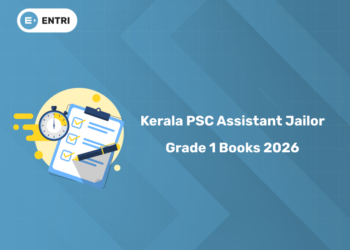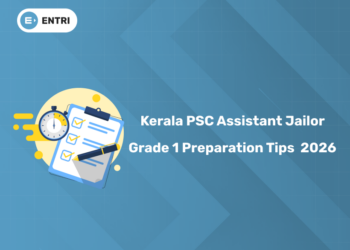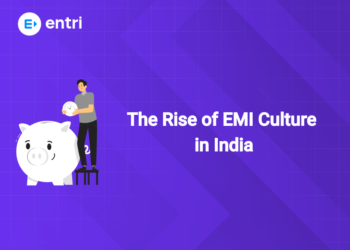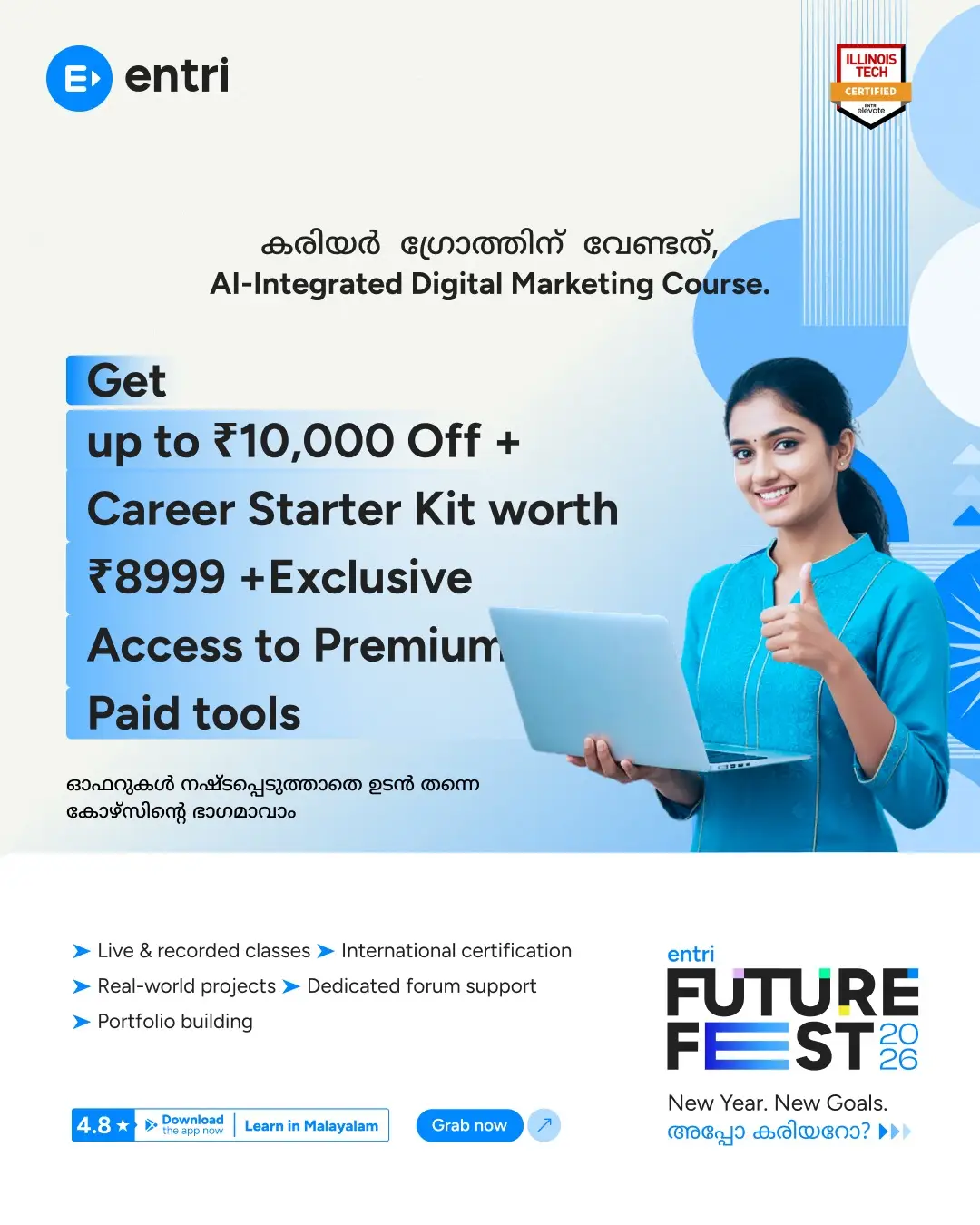Table of Contents
In the dynamic Indian entertainment and cinema exhibition market, PVR (now PVR INOX post-merger) has carved out a strong brand presence not just by building multiplex screens, but by crafting memorable marketing campaigns, digital engagement strategies, and audience-driven experiences. For digital marketers, students and professionals, PVR’s campaigns offer a compelling blueprint: blending technology and data with theatre experience, regionalisation, loyalty programmes and real-time personalisation.
In this blog post, we will:
- Provide an overview of PVR’s business and marketing context
- Detail PVR’s major marketing strategies and channels
- Highlight specific campaign examples that worked and why
- Share measurable outcomes and marketing metrics
- Extract key takeaways for digital marketers and students
- Link how the Entri AI Powered Digital Marketing Course can help you build the skills to execute similar campaigns
PVR’s Business & Marketing Context
Company overview
PVR Ltd (now merged into PVR INOX) began in 1997 as the first true multiplex chain in India, and has grown to operate hundreds of cinemas across dozens of cities. The merger with INOX Leisure has made it the largest exhibitor chain in India, operating in a wide regional footprint.
Market dynamics and competitive landscape
- India’s cinema-going audience has become more segmented: premium experiences (IMAX, Luxe), mid-market families, and cinema for children. PVR recognised this segmentation and built labels accordingly, such as PVR Luxe, PVR Gold, and PVR Playhouse.
- Rapid digital adoption: mobile ticketing, app-based membership, digital offers. PVR has invested in data analytics, customer personalisation, and digital experiences. For instance, they partnered with Salesforce Marketing Cloud to deliver personalised offers based on the last movie watched, snack purchase, etc.
- Growing importance of regional markets and theatre experience: With multiplex penetration expanding beyond metro cities, campaigns need to be localised and inclusive.
Marketing goals
For PVR, the marketing goals are clear:
- Drive footfall to cinemas across all screens and cities
- Increase loyalty and repeat visits through membership and offers
- Enhance the in-theatre experience (not just screen but food & beverage, premium seats)
- Use digital data to personalise and optimise marketing spend
Join Our Online Digital Marketing Course & Learn the Fundamentals!
Key PVR Marketing Strategies & Channels
1: What is the primary goal of SEO (Search Engine Optimization)?
a) Segmentation, Targeting & Positioning
- PVR segments its offering: Premium viewers (Luxe, Gold), family audiences, children/animation (Playhouse), mass entertainment (standard multiplex).
- Target audience: Generally middle to upper‐middle class families, youth (18–35) who are frequent movie-goers, urban and semi-urban markets.
- Positioning: “Bringing smiles”, premium experience, variety of formats (4DX, IMAX, Luxe, P[XL]). The value proposition is not just a movie but a full outing with comfort, snacks, and digital touchpoints.
b) Digital & Data-Driven Marketing
- PVR uses digital channels extensively: website/app, email/SMS, social media, performance ads.
- Notably, PVR’s marketing cloud implementation allows them to query user behaviour: “Customer visited after 3 months and last watched an action movie with pizza & soda; now send 2-for-1 offer in their city.”
- SEO and domain strength: According to one case/story, PVR’s site holds many thousands of organic keywords (~169,598), which reflects strong digital content and visibility.
c) Experiential & In-Cinema Marketing
- In-theatre campaigns, sponsorships, in-screen advertising, and loyalty programmes (PVR Privilege) help drive repeat visits.
- Promotional pricing and bundled offers: PVR uses tiered pricing, bundles of snacks+ticket, loyalty discounts, especially during off-peak times.
d) Regionalisation & Local Market Focus
- With non-metro growth important, PVR tailors offers and communication regionally (language, local festivals, regional movies) to resonate at the local level.
- Their multi-city rollout and acquisition strategy (such as SPI Cinemas in South India) support this.
e) Brand Partnerships, Content & Social Engagement
- PVR partners with film studios, brands for premieres, VIP events, and loyalty activations. The brand uses social media for campaigns like #ouchthecouch where users submitted videos.
- They also ensure their content (trailers, teasers, film launch events) drives traffic not just to their cinema but to their own digital platforms.
Become an AI-powered Digital Marketing Expert
Master AI-Driven Digital Marketing: Learn Core Skills and Tools to Lead the Industry!
Explore CourseSignature Campaigns & Why They Worked
Let’s look at two or three standout campaigns from PVR and analyse what made them effective.
Campaign: #ouchthecouch
- Description: A campaign invited users to submit short videos about how much they missed watching movies in the theatre (especially during lockdowns/limited screenings). PVR then stitched these into a short film and showed it in their theatres and shared it across social.
- Why effective: It tapped into a strong emotional insight that movies are more than content; they’re a communal experience. It built UGC, created theatre-returning excitement, drove social shares, and reinforced the brand relevance of PVR beyond a venue.
- Lesson: Emotional social campaign + UGC + theatre re-opening moment = strong re-engagement.
Campaign: Personalised Offers Using Data
- Description: Using the marketing cloud, PVR sent hyper-personalised offers based on prior attendance, genre preference, and snack purchase behaviour.
- Why effective: Combines data with channel strategy (email, app push) to drive high relevance and repeat visits. The fact that PVR tracks last visit, genre preference, and snack purchase allows segmentation and higher conversion.
- Lesson: Digital-first consumer marketing in India relies on data infrastructure + personalised communication + integrated offline/online experience.
Campaign: Multi-Tiered Pricing + Loyalty Program
- Description: Through its marketing mix, PVR uses tiered seating (IMAX/Luxe vs standard), bundles (ticket + popcorn/drink), off-peak pricing, and loyalty points (PVR Privilege) to influence behaviour and increase spend per customer.
- Why effective: Behavioural economics people respond to perceived premium value (Luxe seat) and deals (off-peak bundling). Loyalty points drive stickiness.
- Lesson: Even entertainment-based brands must optimise pricing, segmentation, and rewards to move from one-time visits to lifetime value.
Metrics & Key Outcomes
Here are some reported metrics and outcomes from PVR’s marketing efforts that help understand impact:
- Reported organic keywords for PVR site: ~169,598 organic keywords, showing a strong SEO footprint.
- Loyalty and behavioural data: Using their CRM/marketing cloud, PVR can personalise at scale, demonstrating investment in data capabilities.
- Segmentation and format rollout: PVR’s premium formats (4DX, Luxe, IMAX) allow them to capture higher margin customers and build brand prestige.
- Market reach: As of 2025 and post-merger, the combined chain has over a thousand screens across India (and Sri Lanka), spanning tier-1 and tier-2 cities.
- Advertising and experiential revenue: PVR’s cinema advertising business (ads before movies) provides a commercial channel that brands pay to advertise in PVR; PVR benefits from diversified revenue.
While theatre footfall had challenges (noted in recent results showing loss in Q1 FY25 due to film slumps) this underscores the importance of having marketing strategies that maintain relevance and drive repeat visits even when content is weak.
Key Takeaways for Digital Marketers & Students
Drawing from PVR’s campaigns, here are the actionable insights you should carry into your own work:
- Understand consumer context and emotions. The “experience of watching in the theatre” vs streaming gave PVR a strong emotional platform. Your campaign must centre a core human insight, not just a product feature.
- Build infrastructure for personalisation. Data-driven marketing (CRM, segmentation, channel orchestration) is non-optional in Indian digital marketing today.
- Use multi-channel synergy. PVR blended social, email, app, offline in-cinema screens, and loyalty for cohesive campaigns keep your media mix integrated.
- Segment smartly. Premium vs standard formats, weekday vs weekend, price tiers, membership vs walk-in tailoring offers to segments, raise ROI.
- Leverage localisation. India is not homogeneous: language, region, and culture matter. Use localised content, regional influencers, and regional offline assets.
- Brand + performance balance. PVR did not just push ticket deals; it also built brand prestige (Luxe, IMAX) and emotional cues around the cinema outing. Your campaigns must mix conversion with storytelling.
- Experiment with customer journey triggers. Re-engagement after three months of non-visit, genre-based offers, and snack bundling all trigger timely behaviour. Identify your own triggers.
- Measure lifetime value, not just the immediate sale. Loyalty programmes, repeat behaviour, and higher-margin formats matter.
- Experience matters. For service/venue brands like PVR, the in-theatre experience (seating comfort, food offering, ambience) is a marketing asset. Consider how your product or service experience supports your campaign message.
- Upskill to execute. If you’re a student or early professional, building skills in campaign analytics, channel strategy, regional digital marketing, and consumer behavioural psychology is essential training courses help.
Become an AI-powered Digital Marketing Expert
Master AI-Driven Digital Marketing: Learn Core Skills and Tools to Lead the Industry!
Explore CourseHow the Entri AI-Powered Digital Marketing Course Aligns
If you’re wondering how to match your skill set with the kind of campaigns PVR runs, here’s how the Entri AI-Powered Digital Marketing Course dovetails neatly:
- Channel mastery: Modules on Meta Ads (Facebook/Instagram), Google Ads, YouTube Ads, and LinkedIn Ads (all key for brand & performance) help you set up campaigns like PVR’s social & search-driven visits.
- Data & personalisation: Course units cover CRM integration, audience segmentation, automation, and personalisation (just like PVR’s marketing cloud example).
- Performance + brand: You’ll learn balancing brand-building storytelling with performance metrics (ROAS, cost per visit, lifetime value).
- Localisation & regional targeting: Skills in regional language content, geo-targeted campaigns, vernacular creatives, let you work in the Indian context.
- Case study-oriented: Analysis of real brands like PVR helps you see what works in practice.
- Hands-on execution: You get to build live campaigns, track metrics, and optimise rather than just theoretical learning.
If you aim to manage or lead digital campaigns for entertainment, venue-based, consumer experience or lifestyle brands, this kind of training gives you the frameworks, tool-sets, and confidence to execute.
Challenges & What to Watch for
No campaign or brand is without headwinds. PVR’s recent results show some warning signs and learning points for digital marketers:
- Circulation of blockbuster content affects footfall; fewer big releases mean lower rollback for theatres hence marketing must also focus on alternative draws (premium formats, loyalty, F&B bundles) to stabilise.
- Digital ad cost inflation: as more brands shift online, performance marketing costs rise. Creative differentiation and optimisation matter.
- Consumer behaviour shifts: streaming OTT options mean theatre brands must emphasise why to go to the theatre, not just movie release. PVR’s experience focus (IMAX, Luxe) is a response.
- Regional depth: Expansion into tier-2, tier-3 requires tailored offers and content; one size does not fit all.
- Attribution complexity: Tracking offline visits (people buying a ticket after an email or social ad) and linking back to the digital channel requires robust analytics.
As you plan campaigns, build in contingency for external variables (content lineup, consumer sentiment, competing entertainment, macro-economics) and ensure your campaign architecture is flexible.
Key Takeaways
- A strong campaign depends on emotion + relevance + context. PVR’s “out-of-home experience” positioning gave them space in consumers’ lives.
- Data-driven personalisation is a differentiator in competitions saturated with digital noise. PVR’s marketing cloud example shows how to operationalise it.
- Multi-channel orchestration (digital, in-theatre, offline activations, loyalty programmes) enables maximum impact; you can’t treat channels in isolation.
- Localisation and segmentation are critical in a diverse market like India one region’s language, festival or consumption habit differs from another.
- Brand-value programmes (premium formats, loyalty) matter for long-term ROI beyond one-off ticket sales.
- For students and professionals, the skill set required is broad: digital ad platforms, analytics, consumer psychology, regional content, and campaign execution.
- Training like the Entri AI Powered Digital Marketing Course gives you the structured knowledge and practical experience to lead such campaigns.
- No campaign lives in perfect conditions; always anticipate variables (content dryness, ad cost shifts, consumer fatigue) and build agility into your strategy.
Join Our Online Digital Marketing Course & Learn the Fundamentals!
Final Word
The story of PVR marketing is not just about selling movie tickets; it’s about creating experiences, connecting digitally and physically, and treating every cinema visit as part of the brand journey. For digital marketers in India’s fast-moving entertainment and lifestyle space, this case offers valuable lessons in strategy, execution, and measurement.
If you’re ready to build your next campaign, whether for entertainment, venue-based service, or consumer-experience brand, use this framework and consider equipping yourself with structured training such as the Entri AI-Powered Digital Marketing Course. With the right mix of skill, insight, and campaign architecture, you’ll be prepared to deliver results in India’s challenging yet rewarding digital marketing ecosystem.
Frequently Asked Questions
What is PVR’s marketing strategy?
PVR’s marketing strategy focuses on creating premium cinema experiences, loyalty programs like PVR Privilege, influencer-led promotions, and regionalised campaigns across India.
How does PVR attract customers?
PVR attracts customers through event-based campaigns, festival screenings, membership rewards, and engaging social media storytelling that highlights comfort and luxury.
What are some popular PVR marketing campaigns?
Some notable campaigns include movie premieres with fan interactions, film festivals, themed food menus, and co-branded influencer activations.
How does PVR use digital marketing?
PVR leverages digital ads, app-based loyalty rewards, CRM emailers, social media storytelling, and performance analytics to drive bookings and customer retention.
What is the PVR Privilege program?
PVR Privilege is a loyalty program offering points, discounts, and exclusive experiences to frequent movie-goers while collecting valuable first-party customer data.
How has the PVR-INOX merger affected marketing?
The PVR-INOX merger created India’s largest multiplex chain, allowing for unified marketing campaigns, stronger partnerships, and data-driven audience targeting.
What can digital marketing students learn from PVR?
Students can learn loyalty marketing, localisation, omnichannel integration, data-driven targeting, and event-based branding strategies from PVR’s playbook.
How does PVR measure marketing success?
PVR tracks success through occupancy rates, average revenue per visitor, repeat bookings, and conversion metrics from its app and website.
Why is localisation important in PVR campaigns?
Localisation helps PVR reach diverse Indian audiences by tailoring campaigns in regional languages and connecting emotionally through cultural relevance.
Where can I learn digital marketing strategies like PVR’s?
You can enrol in Entri’s AI-powered Digital Marketing Course, which covers campaign strategy, performance marketing, localisation, and AI tools used by top brands like PVR.















